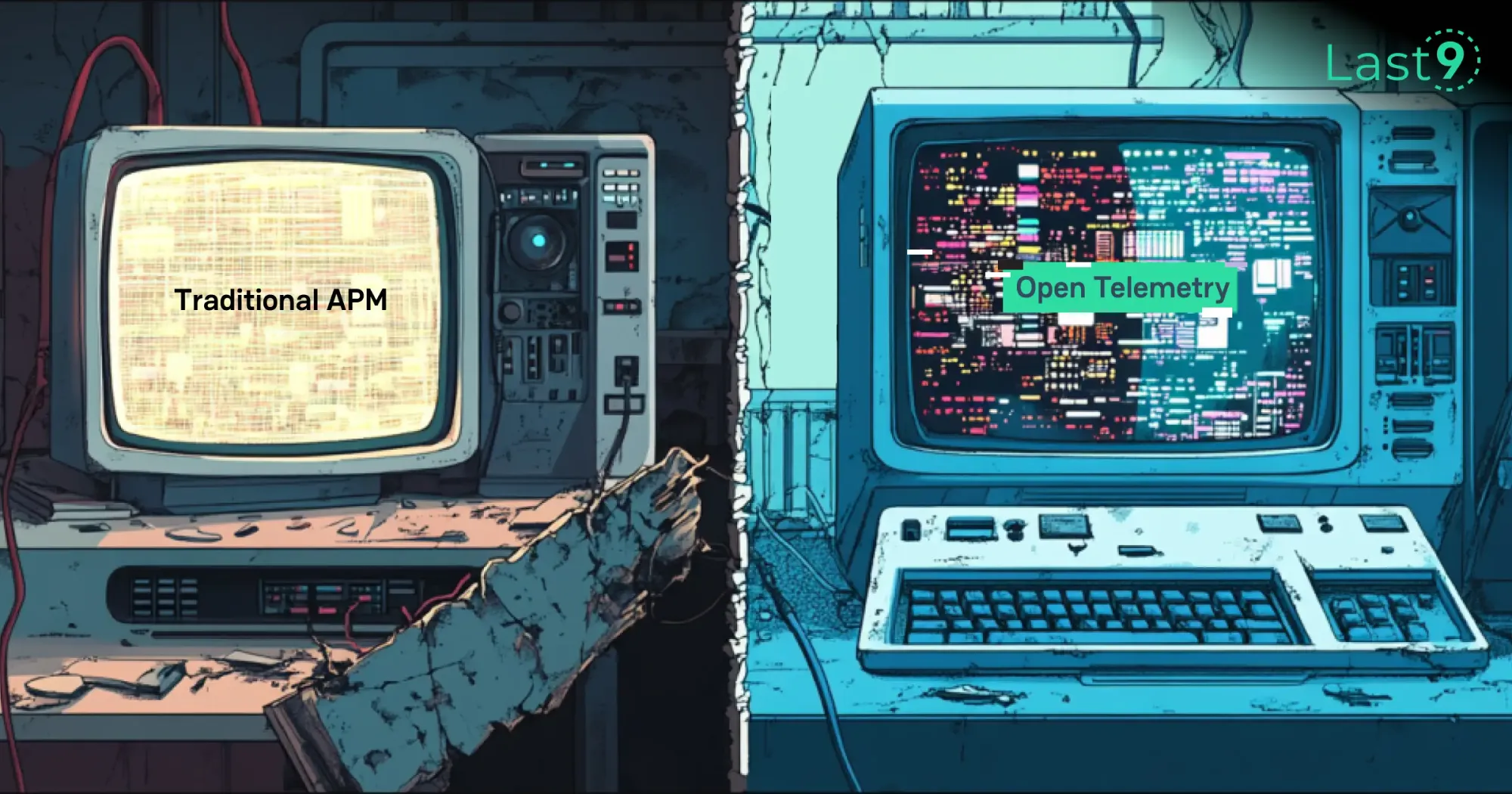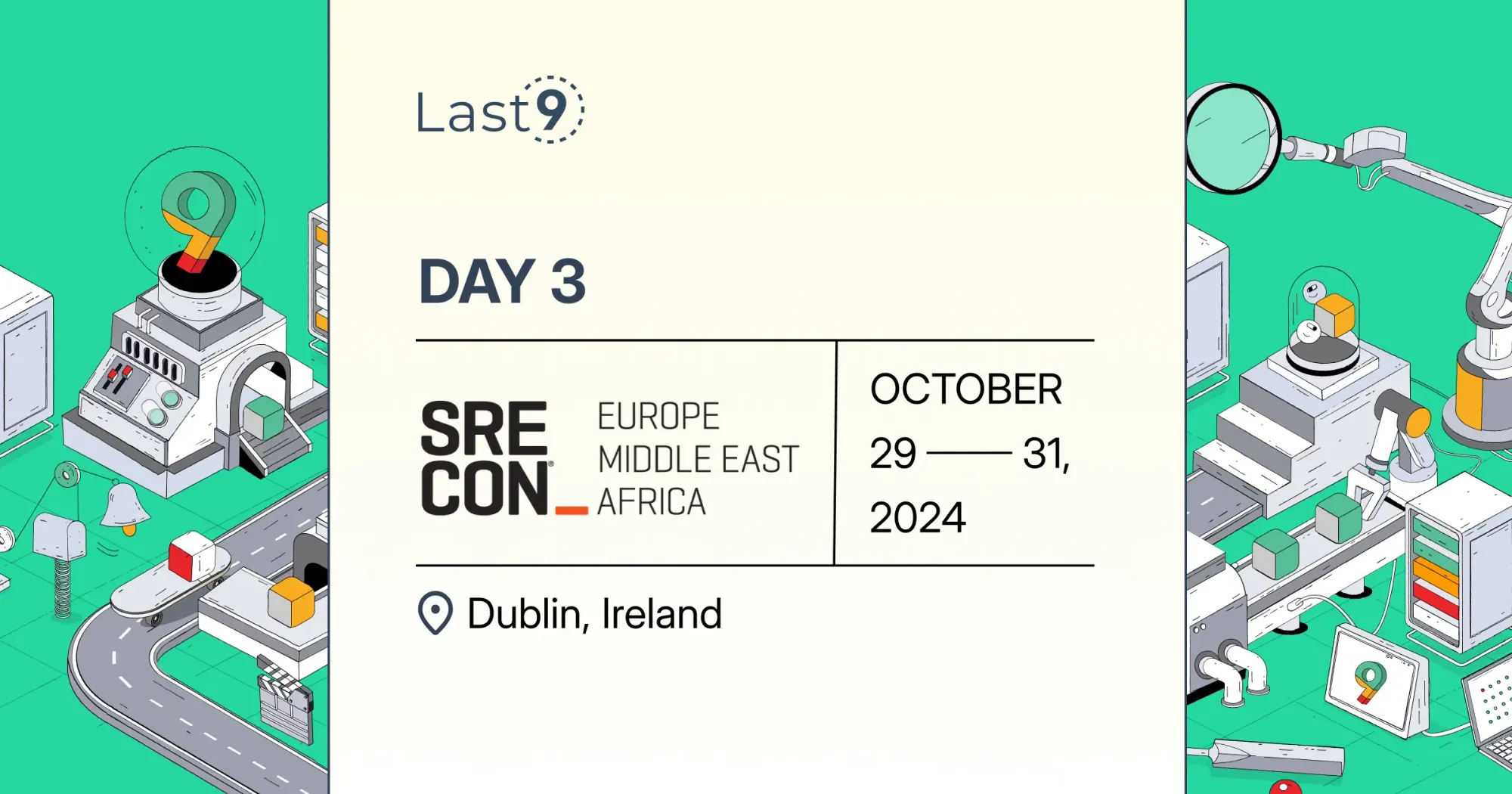Aug 19th, ‘24/6 min read
OpenTelemetry vs. Traditional APM Tools
This article explores OpenTelemetry vs. traditional APM tools, comparing their strengths, weaknesses, and use cases to help you choose wisely.

Introduction:
In an era of complex, distributed systems, ensuring optimal application performance and delivering exceptional real-user experiences is paramount. Traditional Application Performance Monitoring (APM) tools have long been the go-to solution for gaining insights into application behavior. However, the rise of cloud-native architectures and microservices has introduced new challenges that demand a more flexible and scalable approach.
Two major approaches have emerged: traditional Application Performance Monitoring (APM) tools and the more recent OpenTelemetry framework. This article explores these approaches' core differences, strengths, weaknesses, and ideal use cases.
Overview
Observability refers to the capability to assess a system's internal condition by analyzing its external outputs. It involves collecting and analyzing telemetry data to gain insights into system behavior. This data typically includes:
- Metrics: Numerical measurements of system performance over time.
- Traces: Records of requests and their propagation through a distributed system.
- Logs: Textual records of events and activities within a system.
For a deeper understanding of the anatomy of an observability system, including metrics, traces, and logs, check out our in-depth guide.
Traditional APM Tools
Traditional APM tools provide comprehensive, end-to-end solutions offered by single vendors. These tools are equipped with pre-built functionalities for monitoring, alerting, and performance analysis, delivering valuable insights into application behavior and end-user experience.
Examples: New Relic, Dynatrace, AppDynamics, Datadog APM
OpenTelemetry
OpenTelemetry is an open-source framework designed for monitoring and observability in cloud-native applications.
It provides a single set of APIs, libraries, agents, and collector services to capture distributed traces, logs, and metrics from your application.
1. Key Comparison Points and Trade-offs
1.1 Instrumentation
Traditional APM:
- Pros:
- Rapid deployment with auto-instrumentation for dynamically typed languages like Python, Ruby, and Node.js.
- Consistent data collection across supported technologies, simplifying data analysis.
- Cons:
- Limited flexibility for customizing instrumentation to capture specific metrics or events.
- Potential gaps in coverage for unsupported technologies or custom frameworks.
- Vendor lock-in due to proprietary instrumentation agents and data formats, hindering portability.
OpenTelemetry:
- Pros:
- Highly customizable instrumentation through language-specific APIs and libraries, ideal for complex cloud-native applications.
- Supports a diverse array of programming languages and frameworks, offering extensive compatibility.
- Vendor-neutral instrumentation, enabling data portability and flexibility in choosing backend systems.
- Cons:
- Requires more initial setup and configuration compared to auto-instrumentation.
- Demands deeper technical expertise for effective implementation.
- Potential for inconsistencies in instrumentation across different teams or projects without proper governance.
1.2 Data Collection and Processing
Traditional APM:
- Pros:
- Built-in analytics capabilities for identifying performance issues.
- Often includes out-of-the-box anomaly detection and alerting features.
- Cons:
- Limited control over data collection and retention policies, hindering customization.
- Potential data ingestion caps or forced sampling, impacts data accuracy and completeness, especially in high-volume environments or microservices architectures.
OpenTelemetry:
- Pros:
- Complete control over data collection, processing, and storage, enabling tailored analytics pipelines.
- Flexible data model accommodating custom metrics and traces, essential for complex microservices architectures.
- No inherent limitations on data retention or sampling, allowing for in-depth analysis and troubleshooting.
- Cons:
- Requires additional tools for data analysis and visualization.
- More infrastructure is needed to manage the data pipeline, increasing operational overhead.
1.3 Vendor Lock-in
Traditional APM:
- Pros:
- Integrated, end-to-end solutions from a single vendor can streamline support and troubleshooting.
- Cons:
- High switching costs and potential data migration challenges when changing observability solutions.
- Limited flexibility in choosing best-of-breed tools for specific needs.
OpenTelemetry:
- Pros:
- Vendor-agnostic approach promotes flexibility and choice in selecting observability solutions.
- Enables the use of multiple analysis tools to gain deeper insights.
- Cons:
- Requires additional effort to integrate different observability tools and establish a cohesive view.
- Potential for inconsistencies in data formats and metrics across various tools.
1.4 Cost
Traditional APM:
- Pros:
- Predictable pricing models based on hosts or applications, often with bundled functionality.
- Includes the cost of analysis tools and dashboards within the subscription.
- Cons:
- Total cost of ownership can escalate rapidly with increasing scale and complexity.
- May necessitate suboptimal sampling to manage costs, potentially impacting data accuracy.
OpenTelemetry:
- Pros:
- Open-source core with no licensing fees, reducing upfront costs.
- Potential for lower overall costs at scale due to flexible deployment options.
- Cons:
- Requires additional investments in data storage, processing, and analysis tools.
- May demand specialized in-house expertise to build and maintain the observability infrastructure.
1.5 Ease of Use
Traditional APM:
- Pros:
- Generally quicker and simpler initial setup, enhancing user experience
- Pre-built dashboards and alerts provide immediate insights.
- Cons:
- Limited flexibility can hinder troubleshooting complex issues
- steep learning curve for mastering advanced features and customizations.
OpenTelemetry:
- Pros:
- High degree of customization and flexibility to tailor the solution to specific needs.
- Consistent API across different languages and frameworks improves user experience for developers.
- Cons:
- Requires more technical expertise and time investment for initial setup and configuration.
- Ongoing maintenance and management can be more complex.
1.6 Community and Ecosystem
Traditional APM:
- Pros:
- Dedicated vendor support and training resources.
- Regular product updates and new feature development aligned with vendor roadmap.
- Cons:
- Reliance on vendor's priorities for feature development and optimization.
- Limited integration options beyond the vendor's ecosystem.
OpenTelemetry:
- Pros:
- Large, active open-source community fostering rapid innovation and optimization.
- Broad ecosystem of compatible tools and integrations for enhanced flexibility.
- Cons:
- Community support can vary in quality and responsiveness compared to commercial support.
- Potential for breaking changes due to the fast-paced nature of open-source development.
2. Use Cases
Scenario 1: Large Enterprise with Diverse Technology Stack
- Traditional APM: May struggle to provide comprehensive visibility across a heterogeneous technology stack, potentially impacting response times and downtime due to blind spots.
- OpenTelemetry: Better suited to handle diverse environments through wide compatibility and customization options, enabling effective monitoring and troubleshooting.
Scenario 2: Small Startup with Limited Resources
- Traditional APM: Offers a quicker path to initial observability but may lead to higher long-term costs as the startup grows and needs to expand.
- OpenTelemetry: While requiring a larger upfront investment, provides a more scalable and cost-effective foundation for managing increasing complexity and potential downtime.
Scenario 3: Highly Regulated Industry with Specific Data Requirements
- Traditional APM: May have limitations in meeting strict data retention and compliance requirements, potentially leading to regulatory risks.
- OpenTelemetry: Offers greater control over data collection, storage, and retention, enhancing the ability to meet industry regulations and mitigate potential downtime due to data loss.
3. Performance Overhead
Traditional APM:
- Generally has a low performance overhead but can vary significantly across vendors.
- In high-throughput scenarios, the overhead of data collection can impact application latency and overall performance.
OpenTelemetry:
- Designed with minimal performance overhead in mind to reduce impact on application performance.
- Offers configuration options like sampling and filtering to fine-tune overhead based on specific requirements, helping to optimize for latency and resource utilization.
4. Future Trends
Traditional APM:
- Expanding AI and ML capabilities for predictive insights to enhance user experiences.
- Broadening coverage to encompass a wider range of cloud-native environments.
OpenTelemetry:
- Rapidly expanding adoption in cloud-native landscapes.
- Continuously evolving through community-driven innovation.
- Expanding data capture to logs and profiles for comprehensive insights.
Traditional APM Tools vs. OpenTelemetry
Feature | Traditional APM | OpenTelemetry |
Instrumentation | Auto-instrumentation, vendor-specific | Manual configuration, standardized across languages |
Setup Time | Quick | Longer initial setup |
Customization | Limited | Highly customizable |
Data Control | Limited | Full control |
Vendor Lock-in | High | Low |
Cost Model | Per host/application, can be expensive at scale | Open-source core, costs for storage and analysis |
Ease of Use | Generally easier for basic use cases | The steeper learning curve, more complex for advanced scenarios |
Out-of-the-box Analysis | Included | Requires separate tools |
Community Support | Vendor-specific | Large open-source community |
Ecosystem | Limited to vendors and partners | Broad, open ecosystem |
Performance Overhead | Generally low, but variable | Designed for low overhead, configurable |
Scalability | Can be costly at scale | More cost-effective at scale with proper configuration |
Future-proofing | Dependent on vendor roadmap | Community-driven, rapidly evolving |
Multi-cloud Support | Varies by vendor | Strong, vendor-agnostic |
Compliance & Data Sovereignty | Depends on vendor offerings | Fully controllable |
5. Conclusion
Choosing between OpenTelemetry and traditional APM tools depends on your specific needs, resources, and long-term strategy.
Traditional APM tools offer a more streamlined, out-of-the-box experience, which can be beneficial for teams looking for quick setup and immediate insights. They're often a good fit for organizations with less complex environments or those who prefer a managed solution.
Conversely, OpenTelemetry offers unparalleled flexibility, customization, and vendor independence, empowering organizations to build tailored observability solutions. This approach is particularly advantageous for complex, distributed systems demanding deep insights and granular control for efficient root cause analysis.
Many organizations are now adopting a hybrid approach, using OpenTelemetry for data collection and traditional APM tools or other analysis platforms for visualization and alerting. This approach combines the flexibility of OpenTelemetry with the advanced features of established APM solutions.
Ultimately, the choice between OpenTelemetry and traditional APM tools should be based on a careful evaluation of your organization's specific needs, technical capabilities, and long-term observability strategy.
Additional Resources
Contents
Newsletter
Stay updated on the latest from Last9.
Helping to make the tech a little less intimidating. I love breaking down complex concepts into easy-to-understand terms.
Handcrafted Related Posts

How we tame High Cardinality by Sharding a stream
Using 'Sharding' to tame High Cardinality data for Levitate - Our Time Series Data Warehouse
Piyush Verma

Systems Observability
Observability is not just about being able to ask questions to your systems. It's also about getting those answers in minutes and not hours.
Nishant Modak, Piyush Verma

SRECon EMEA 2024 - Day 3
Here’s a snapshot of the key talks, important ideas, and memorable moments that set the stage for SRECon EMEA Dublin 2024!
Prathamesh Sonpatki